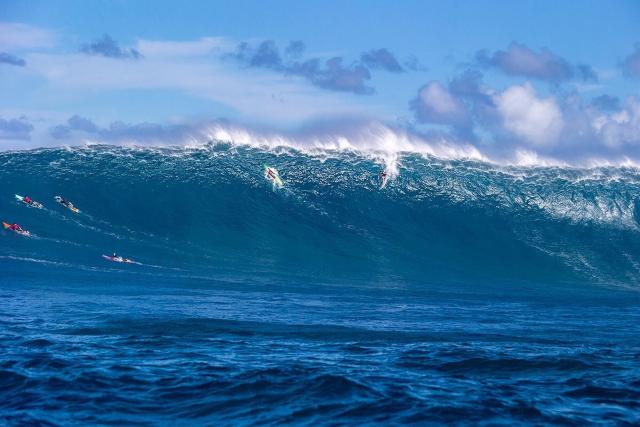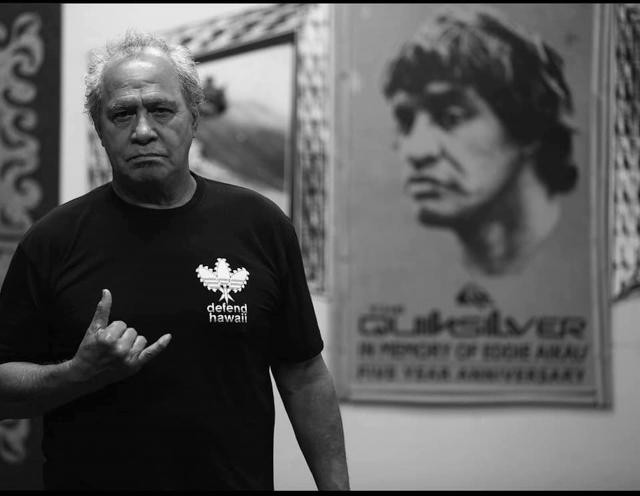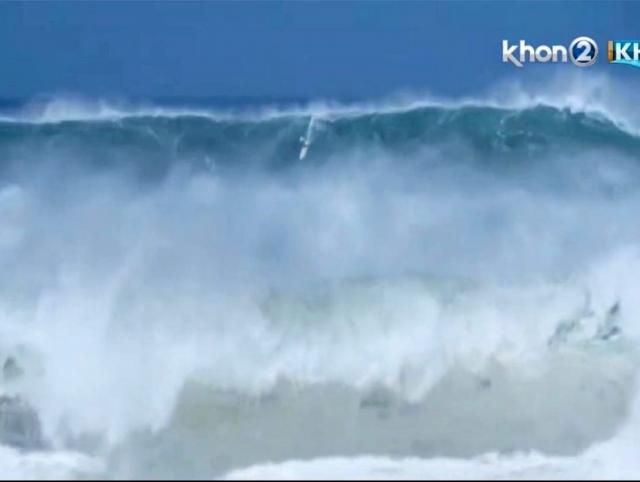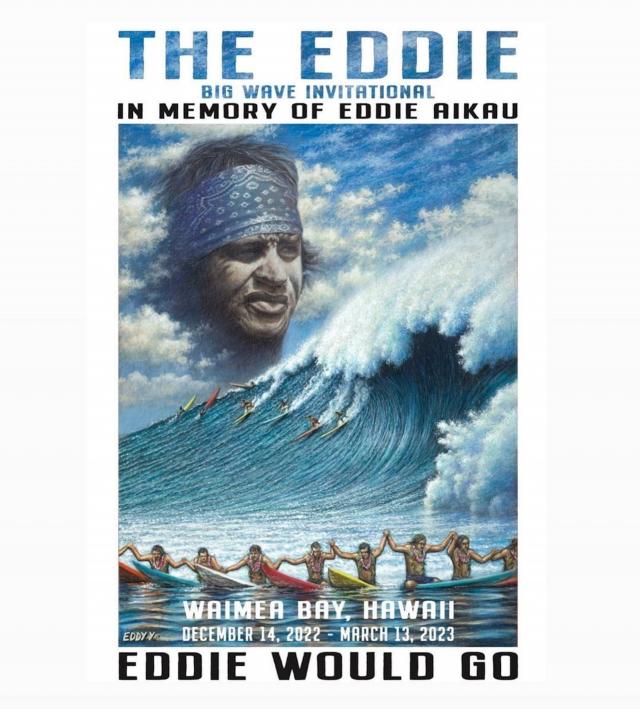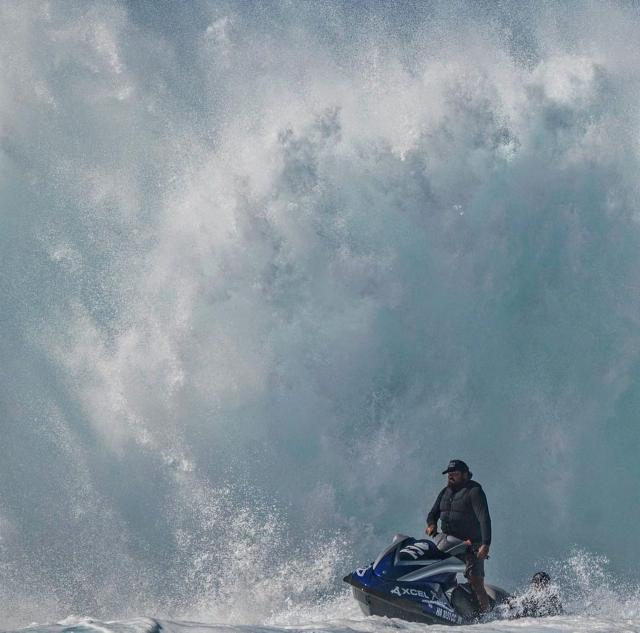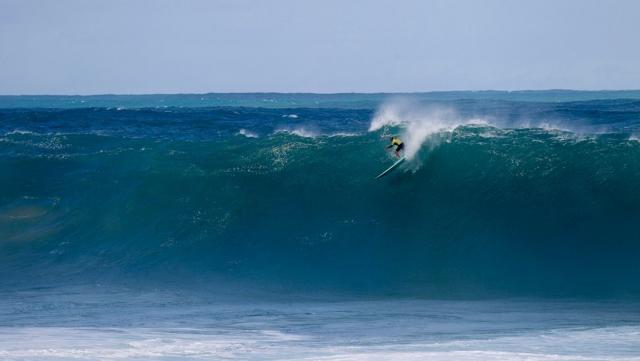Everyone in Hawaii knows that Eddie would go.
It’s not just that it’s been the most popular bumper sticker in the Islands for more than 30 years, honouring the memory of a famous big wave surfer and decorated lifeguard. It’s because it’s the call to action for the world’s most watched, most death-defying surfing event in the world. When “the Bay calls the day”, as they say, it means that waves more than 20 feet high and almost as thick are expected to roll into beautiful Waimea Bay on Oahu’s North Shore all day, giving the 40 invitees to the Eddie Aikau Memorial Big Wave Invitational a platform for unbelievable heroics over two very long heats.
When contest director Clyde Aikau, Eddie’s younger brother and a former winner of the prestigious title, calls the Eddie on, the island of Oahu goes nuts. Streams of traffic clog the freeway out of Honolulu and the two-lane Kam Highway along the North Shore is bumper to bumper soon after dawn. People walk miles from wherever they can find parking, then jostle to find a patch of sand or a clump of rocks at a safe distance from the awesome power of a turbulent sea that they’ve come to witness. The Eddie is sometimes called the Super Bowl of Surfing, but it’s much more than that because it is such a rare treat to see it proceed.
There have been 34 opening ceremonies since its debut in the middle ‘80s, but the Eddie has gone only 10 times because of its strict adherence to minimum wave size. Unless it’s going to be massive all day, it’s not on. Even this year’s event was given the green light a week earlier and then cancelled when swell conditions looked to be right on the minimum. Last Sunday’s Eddie, held in monstrous conditions, with powerful and groomed 25 to 30 feet sets marching into the bay consistently all day, was the first time Eddie had gone since 2016.
The Honolulu-based Aikau clan (or ohana) was beachboy stock and highly respected along the Waikiki strip when Eddie and Clyde started to make names for themselves in surfing contests in the middle 1960s. Eddie made the final of his first Duke Kahanamoku Classic in 1966, the same year he made his debut at Waimea Bay, fearlessly taking on huge waves with the big wave pioneers. Soon both brothers were respected big wave riders, and Eddie also became the first permanent lifeguard on the frequently treacherous North Shore strip, where he saved hundreds of lives.
I first met the Aikaus in the winter North Shore season of 1976, when they sat either side of a trembling teenaged Mark Richards and brokered a truce in a war that had broken out between locals and visiting surfers. I got to know them better a few months later when Eddie and Clyde came to Queensland for the first Stubbies Classic at Burleigh Heads in 1977. I remember them turning up in singlets and boardies for a civic reception with Gold Coast mayor Sir Bruce Small. The mayor looked askance at the start, but he was soon won over with Eddie and Clyde talking story and signing the old Hawaiian songs between beers.
A year later Eddie was dead before he turned 32, after the Hokule’a, a replica of an ancient Polynesian boat he had been crewing on, ran into trouble off the island of Lanai. While the rest of the crew hung onto the capsized boat, Eddie started paddling for the shore, 20 kilometres away. He was never seen again.
In 1984 North Shore surfer Eddie Rothman introduced the surviving Aikau family to Bob McKnight, the CEO of Quiksilver, and talked about funding a surfing contest in Eddie’s honour. McKnight didn’t need much persuasion and the first Eddie was held at Sunset Beach late in 1984. But McKnight felt something was missing. Eddie was a Waimea big wave hero. It had to be a Bay event, and because the perfect big days are not guaranteed every season, the Quiksilver In Memory of Eddie Aikau would have a three-month waiting period and only run when conditions were perfect. The Eddie did go at the Bay in 1986, and fittingly it was won by Clyde Aikau.
Quiksilver bowed out of its 30-year sponsorship in 2016 but the Aikaus managed to scratch the funds together and staged a great event, won by rising big wave star John John Florence, while Clyde Aikau made a solid showing at the age of 66. This year it looked like John would make it two in a row (the first surfer to do so) but then local lifeguard Luke Shepardson rode three of the biggest waves ever ridden at the Eddie and took out the prize.
It was a victory for the ages, but for me, watching a rather wobbly streaming of it in Noosa, it was the old blokes who were the real stars. Uncle Clyde directed rather than surfed, but the generation was represented by Uncle Michael Ho, 66, who surfed alongside son Mason and did it with style. And Australia’s veteran big wave charger, Ross Clarke Jones, who won it in 2001 in the only Eddie I’ve seen from the beach, made a few absolute bombs that would have gladdened the heart of anyone nudging 60.

